- BeraChain Overview
Berachain is a high-performance Layer 1 blockchain focused on the DeFi ecosystem, built on the Cosmos SDK and combined with the CometBFT consensus engine to achieve faster transaction speeds and lower transaction costs. It adopts a Proof of Liquidity (PoL) consensus mechanism, enhancing EVM compatibility through its self-developed Polaris Ethereum module, allowing developers to seamlessly integrate existing EVM tools and applications.
As a developer-friendly blockchain with strong cross-chain interoperability, Berachain aims to connect EVM and Cosmos ecosystem liquidity, creating an efficient and highly liquid multi-chain network.
- Innovation
2.1 PoL Consensus Mechanism
BeraChain does not adopt the currently popular Proof of Stake (PoS) consensus mechanism but instead chooses a unique Proof of Liquidity (PoL) consensus mechanism, which is an innovative consensus mechanism designed to enhance security by increasing on-chain liquidity. It draws on the concept of PoS, using the native Gas token ($BERA) as initial collateral to secure the network, but further expands on this by introducing a governance token ($BGT) mechanism. Users can earn rewards by delegating governance tokens, thereby enhancing ecological incentives. In simple terms, PoL separates the tokens that pay Gas and provide security ($BERA) from the tokens that govern and distribute on-chain rewards ($BGT, Berachain Governance Token), making network operations more efficient.
2.1.1 Limitations of PoS
The PoS consensus mechanism has made progress in improving the security, decentralization, and transaction speed of blockchains, but it still falls short in incentivizing developers and ordinary users. Ethereum (ETH) is a typical example. In the Ethereum network, ETH is primarily used to pay Gas fees, facilitate transactions, and stake for validators. Validators need to stake ETH to participate in transaction validation and new block creation, thereby maintaining network security and earning rewards by successfully validating blocks. However, ordinary users and developers do not have direct incentives at the protocol level, which may reduce their willingness to participate.
Additionally, PoS faces a conflict between staking and liquidity. Taking the Ethereum network as an example, users must either choose to stake ETH to secure the network or use it for on-chain transactions, but cannot do both simultaneously. More staking means higher security but reduces the liquidity of the ecosystem; conversely, lowering the staking ratio may enhance liquidity but weaken network security. This mechanism of "using the same funds to protect the network and support transactions" inherently presents a trade-off issue, making it difficult for PoS networks to find a perfect balance between security and liquidity.
2.1.2 How PoL Solves the Problem
As mentioned above, PoS primarily has two issues:
It cannot effectively incentivize three parties at the protocol level: validators, users, and applications (developers).
It struggles to balance the conflict between on-chain staking security and liquidity.
PoL can better incentivize all participants in the blockchain network, achieving simultaneous expansion of both security and liquidity while providing real value to on-chain applications.

Image source: Berachain Blog
In the PoS mechanism, block rewards are primarily distributed to validators and stakers, making it difficult for ecological applications to benefit. Berachain has established reward vaults for various applications and related mechanisms to facilitate collaboration among validators, applications, and users to generate profits. The reward vault is essentially a smart contract that can accept $BGT from validators and staking tokens from users. The participation process among the three parties is as follows:
After validators generate blocks and receive $BGT rewards, they can choose to allocate $BGT to different application reward vaults; at this point, to compete for the validators' $BGT allocation, applications can "bribe" validators with their native tokens (or other valuable liquidity tokens) to have a portion of the $BGT rewards allocated to their own reward vaults.
Applications receiving $BGT allocations from validators can distribute these $BGT as rewards to users who add liquidity to their LP pools, thereby attracting users to provide liquidity to their pools.
When users choose to add liquidity to different application LP pools, they will select applications that offer more $BGT rewards to earn a share of $BGT from the applications; at the same time, users can claim $BGT rewards based on their LP ratio. For example, if a validator allocates 10 $BGT to application A's vault, and a user has a 10% LP weight in that vault, they will receive 1 $BGT reward.
At this point, users can choose to burn the $BGT reward they received 1:1 into $BERA, or they can re-delegate the $BGT they received to the validator. When the validator receives token "bribes" from applications, the user, as a delegator, can also earn a share of the application tokens from the validator. For example, if validator X allocates 10 $BGT to application A's vault and receives 100 AToken from application A, most of these 100 AToken will flow back to users who delegated $BGT to validator X.
Why do validators need users' $BGT delegation? Because on Berachain, when a validator generates a block, the $BGT rewards they can earn are proportional to the delegation weight they receive. According to the Berachain official documentation, the current base reward for generating a new block on Berachain is 0.5 $BGT, which needs to be calculated and distributed through the "distributor" smart contract.
Thus, validators need more $BGT delegation to increase block rewards, and more rewards can further flow back to users through applications, helping applications gain more liquidity from users in the process, forming an incentive loop that enhances the vitality and liquidity of the Berachain ecosystem, thereby creating the flywheel effect of Berachain.

Image source: Berachain Docs Chinese Version
At the same time, to address the conflict between on-chain staking and liquidity that PoS struggles with, Berachain separates the on-chain payment token $BERA and the governance token $BGT. $BERA serves as the network's gas token, used to pay transaction fees and support the network's basic operations. In contrast, $BGT is used for governance, is non-transferable, and ensures that decision-making power belongs to long-term holders who genuinely care about the network's development. Coupled with the aforementioned PoL mechanism, it constructs an ecosystem where liquidity and security coexist, allowing liquidity to not only enhance the chain's security but also create real value for on-chain applications.
2.1.3 Flywheel Effect
In section 2.1.2, we described the formation process of Berachain's flywheel effect, which is essentially a mutually incentivizing process formed through close coordination among validators, applications, and users.
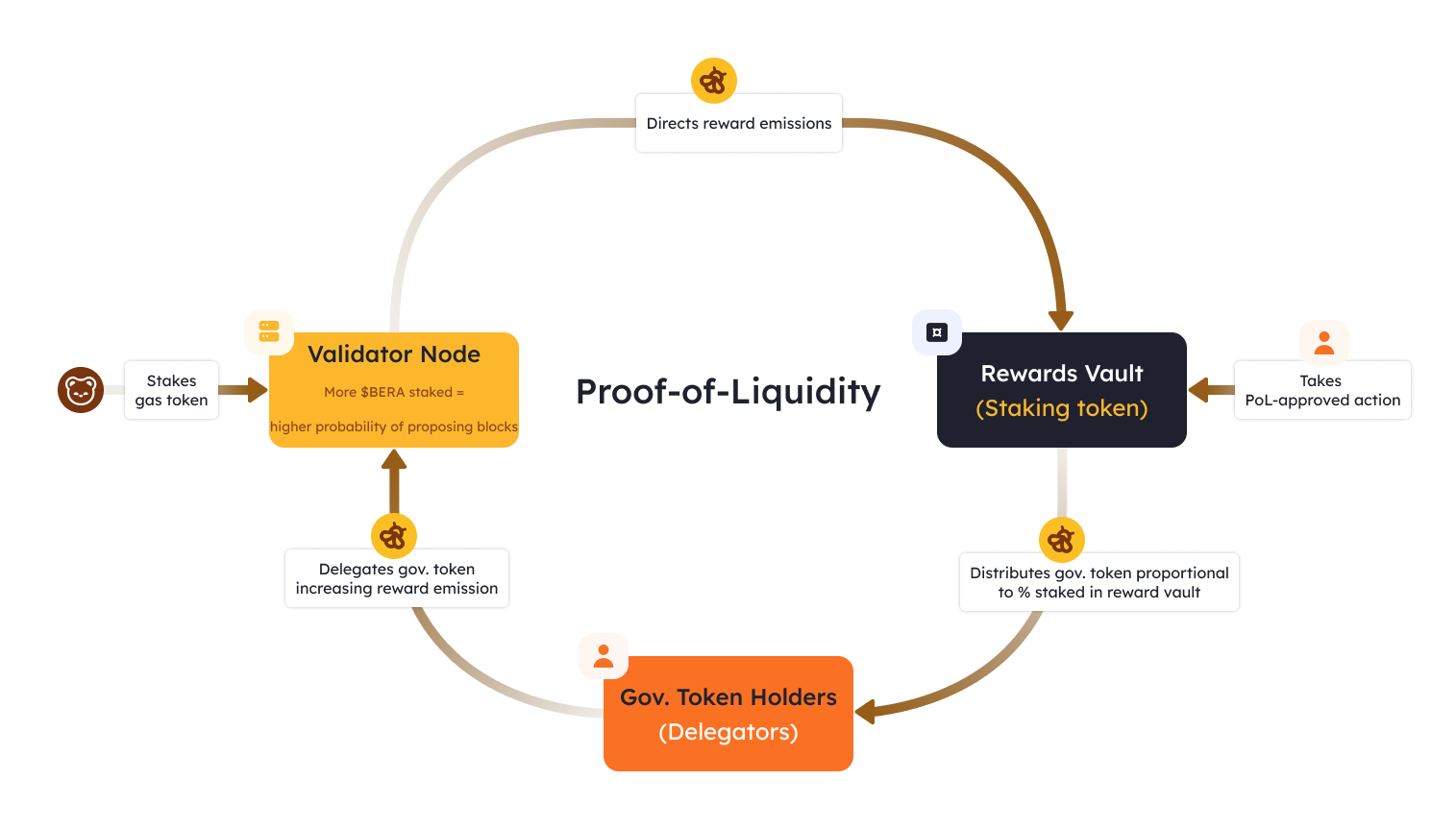
Berachain Flywheel Effect. Image source: Berachain Core Docs
The above image is the flywheel effect framework released by Berachain. Here, we revisit and understand the implementation process of the flywheel effect:
First, validators need to stake a certain amount of $BERA as node collateral to start a node.
When a validator generates a new block, they receive $BGT as a block reward; the amount of $BGT reward a validator can receive at this time depends on the $BGT delegation weight they receive from users.
The validator can then decide to allocate the $BGT block rewards they receive to different application vaults, with the allocation ratio determined by the validator themselves.
At this point, applications can bribe validators to allocate the $BGT rewards to their own vaults.
Applications will distribute the $BGT rewards they receive to users who provide liquidity for them, distributing the corresponding proportion of $BGT based on the user's weight in that pool.
Suppose application A has A-Token. This application wants to increase the liquidity of the A-Token/Bera pool. To do this, application A decides to bribe the validator with 100 A-Tokens, while the validator allocates their 10 $BGT to the A-Token/Bera LP pool.
Users want to earn $BGT, so they will add liquidity to this LP pool. Suppose a user has a weight of 10% in the A-Token/Bera LP pool, then application A will distribute 10*10% = 1 $BGT to that user from the $BGT they received from the validator.
After receiving $BGT, users can re-delegate the $BGT they obtained to the validator. When the validator receives the "bribe" from the application, the user will also receive corresponding token distributions based on their delegation weight.
Thus, a tripartite interest community is formed among validators, applications, and users, which is the flywheel effect:
Validators receive $BGT rewards for generating blocks, as well as incentives from the application's "bribe."
Applications attract liquidity from users.
Users earn $BGT distributions from applications by providing liquidity, and they also receive block reward distributions from validators by delegating $BGT.
Applications can also choose to run their own node and become validators. At this point, as validators, they can allocate the $BGT block rewards they receive to their own application vaults, attracting users to provide liquidity to their pools. This way, they can achieve dual rewards as both validators and applications.
2.2 Three-Token Economic Model
Unlike the single native token economic model commonly used by traditional public chains, BeraChain adopts a three-token economic model to better meet the balance needs among validators, users, and applications. The three tokens are the Gas token $BERA, the governance token $BGT, and the native over-collateralized stablecoin $HONEY.
2.2.1 Economic Model
$BGT - Governance Token
Used for on-chain governance, voting on key matters such as whitelisting assets. $BGT is non-transferable and can only be generated by staking $BERA or providing liquidity on Berachain's native decentralized exchange BEX, ensuring long-term participation and alignment of incentives for holders.
$BERA - Gas Token
Primarily used to pay Gas fees on the Berachain network, it can be obtained through a 1:1 one-way burn of $BGT, issued at a 10% inflation rate, with supply increasing over time. Users can earn $BERA as rewards by staking assets while participating in protocol revenue sharing. Because of the governance token $BGT, users can freely use $BERA for staking without weakening the blockchain's validation capacity, eliminating the need to choose between staking and trading.
$HONEY - Stablecoin
Berachain's native over-collateralized stablecoin, with at least 150% over-collateralization to ensure a peg to the US dollar. $HONEY serves as a medium of exchange within the Berachain ecosystem, also used for protocol revenue distribution, supporting purchases and usage within BEX and applications.
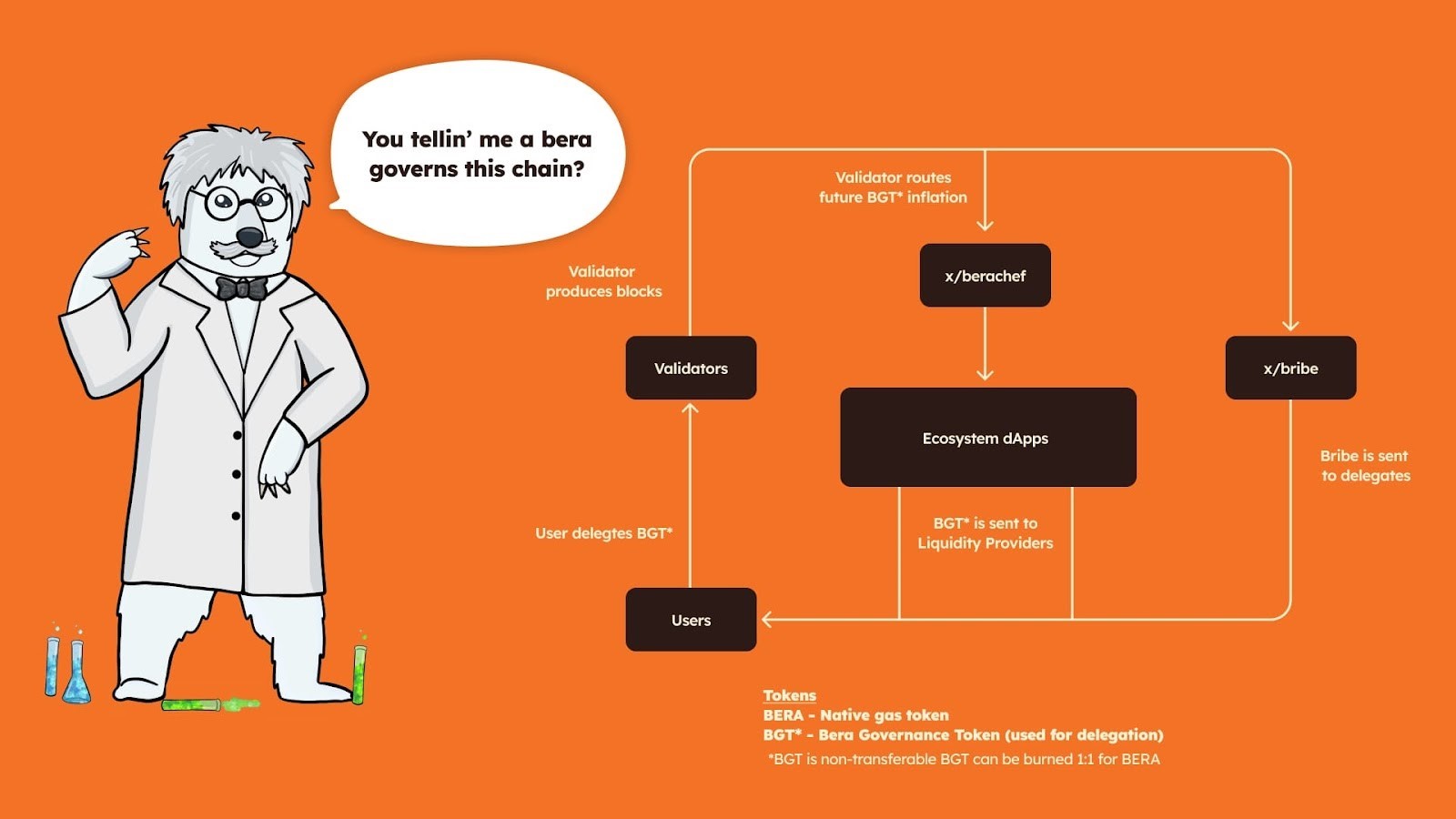
Image source: Berachain Blog
Ecosystem Empowerment
$BERA empowers on-chain transactions, allowing users to earn $BGT governance tokens by staking $BERA and earn protocol revenue (part of which is paid in $HONEY).
$BGT serves as the core of governance, allowing users to influence Berachain's ecosystem rules through voting while promoting liquidity growth.
$HONEY acts as a stable value medium circulating within the ecosystem, providing users and protocols with a stable payment method while rewarding $BERA stakers.
2.2.2 Project Revenue
Berachain's main sources of income include liquidity mining rewards, blockchain infrastructure service fees, developer tools and support fees, and revenue from partnerships. Through the Proof-of-Liquidity (PoL) consensus mechanism, the project can generate revenue from liquidity mining; at the same time, providing high-performance blockchain infrastructure, developer tools, and support services may also bring in income. Additionally, collaborations with other blockchain projects and enterprises constitute an important source of revenue.

Berachain transaction fee revenue. Data source: Dune Analytics
- Ecosystem
Since its testnet, Berachain has garnered significant attention, and its ecosystem is now quite mature, covering areas such as DeFi, NFT, Meme, Gamefi, and AI. According to Defillama data, the projects with the highest TVL on Berachain are as follows: currently, the highest TVL is the liquidity staking project Infrared Finance, with a TVL of $1.935 billion, followed by Berachain's native DEX Kodiak and BEX, with TVLs of $980 million and $894 million, respectively.

Berachain ecosystem TVL ranking. Data source: defillama
3.1 Ecosystem Projects
DeFi
Currently, Berachain's DeFi matrix covers trading, lending, derivatives, and other scenarios, forming a complete landscape.
DeFi - DEX
BEX is the native DEX launched by Berachain, where users can directly buy and sell various tokens, such as exchanging the native token $BERA for the stablecoin $HONEY or trading other ecosystem project tokens; at the same time, users can deposit funds into specific trading pools (such as USDC/$HONEY, W$BERA/$HONEY, etc.) to receive liquidity provider tokens (LP tokens), which can then be staked to earn $BGT. With the existence of BEX, other DEXs in the Berachain ecosystem are also actively preparing various more convenient and efficient services and strategies to attract users and liquidity. Currently, BEX's swap supports multiple tokens, and the TVL of its liquidity pool is close to $400 million.
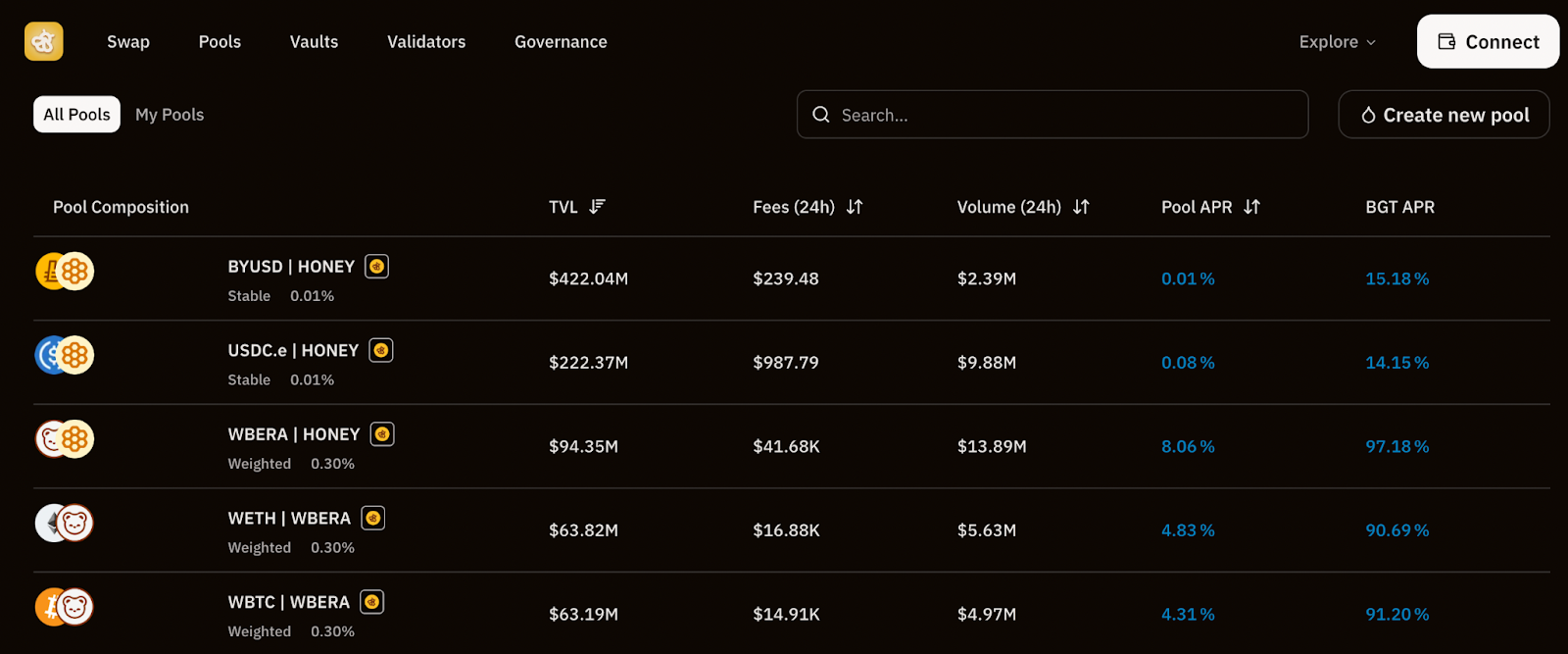
BEX liquidity pool. Image source: BEX Official Website
BEX adopts an AMM (Automated Market Maker) model, replacing traditional order book markets with liquidity pools. The architecture of BEX is designed for flexibility and efficiency, optimizing the trading experience:
Full-range liquidity pools: Supporting traditional "Uniswap V2 style" liquidity pools, providing a simple and smooth trading experience.
Customizable pool weights: Supporting custom weight allocations (e.g., 80/20) to meet personalized investment needs.
Stablecoin exchange curves: Optimized for trading pegged assets, reducing slippage.
Unified vault architecture: Enhancing capital efficiency while reducing Gas fees.
Kodiak is the only DEX incubated by Berachain's "Build-a-Bera" accelerator program, specifically designed to introduce concentrated liquidity and automated liquidity management to the Berachain ecosystem. It not only provides traders with the deepest liquidity and best trade execution but also grants protocols and liquidity providers greater flexibility and control.
As a native DEX in the Berachain ecosystem, Kodiak and BEX serve as complementary liquidity solutions: BEX, as a multi-asset AMM, offers a wide range of liquidity trading options, but BEX does not provide aggregation of liquidity features, while Kodiak focuses on concentrated liquidity solutions, automatically pooling funds deposited into "Kodiak Islands" within a price range, thereby efficiently providing liquidity to the ecosystem, eliminating manual operations, and enhancing capital efficiency and flexibility.
Kodiak offers the following key features, providing traders and liquidity providers (LPs) with the best trading experience through concentrated liquidity and automated liquidity management, while simplifying the complexities of liquidity provision:
Kodiak DEX: A non-custodial decentralized exchange that employs a concentrated liquidity automated market maker (AMM) to enhance capital efficiency. It intelligently optimizes trading paths to improve returns.
Kodiak Islands: An automated liquidity management vault that provides automated LP tools, allowing liquidity providers to maximize profitability without manually adjusting their capital ranges by automatically adjusting positions to fit market conditions.
Sweetened Islands: An innovative incentive layer that offers additional token rewards to liquidity providers. Through Berachain's PoL mechanism, it incentivizes liquidity providers, ensuring ample and stable ecosystem liquidity.
Panda Factory: Supports anyone in deploying new tokens with initial liquidity without code, simplifying the token creation process. This permissionless solution lowers the barrier for new projects, fostering innovation and expanding the Berachain ecosystem.
Kodiak has currently secured $2 million in funding from well-known VC firms such as Amber Group and Shima Capital. With these core features, Kodiak is expected to become one of the most important liquidity provision platforms on Berachain in the future, supporting the sustainable development of the DeFi ecosystem. More information: https://documentation.kodiak.finance/kodiak-boyco
In addition to the two native DEXs mentioned above, Berachain currently includes many other DEX projects that are building a robust infrastructure for efficient trading and liquidity management on the Berachain mainnet.
Honeypot Finance is a liquidity management protocol designed around the Berachain PoL mechanism, helping protocols efficiently manage and grow liquidity, optimizing returns through smart strategies to enhance capital efficiency for liquidity providers. As a PoL accelerator in the Berachain ecosystem, Honeypot aims to empower the community with a full suite of DeFi tools to improve liquidity efficiency. Its core products include DreamPad, HelonDEX, and HiveNode, collectively building a complete closed loop for liquidity acquisition, retention, and incentives. The entire Honeypot ecosystem uses DreamPad as the liquidity entry point, allowing users to directly inject launched token pairs into HelonDEX for trading and liquidity provision, ultimately receiving PoL incentives through HiveNode, continuously enhancing capital efficiency and user returns in the Berachain ecosystem.
Ooga Booga is a liquidity aggregator on Berachain that integrates order flows from multiple DEXs, improving trading efficiency, optimizing trading costs, and pooling liquidity from various DEXs to provide users with the best trading paths and lowest-cost trade execution. According to its official website, the platform has achieved a cumulative trading volume of $600 million.
Shogun is a cross-chain abstract trading protocol that allows users to seamlessly execute trades across multiple chains, simplifying the cross-chain trading process within and outside the Berachain ecosystem, enhancing interoperability and user experience.
Beradrome: A ve(3,3) mechanism DEX on Berachain, similar to Velodrome, adopting a voting lock-up economic model that incentivizes liquidity providers and traders while optimizing trading efficiency and capital utilization.
Yeet: A decentralized leveraged trading protocol on Berachain that supports efficient leveraged trading, allowing users to engage in trustless margin trading on-chain while leveraging the deep liquidity of the Berachain ecosystem to enhance the trading experience.
DeFi - Liquidity Staking
Infrared Finance simplifies the process for users to participate in Berachain's Proof of Liquidity (PoL) mechanism through innovative solutions, enhancing liquidity in the Berachain ecosystem. According to Defillama data, the current TVL on Infrared Finance is approximately $1.871 billion, making it the DeFi protocol with the highest TVL on the Berachain chain.
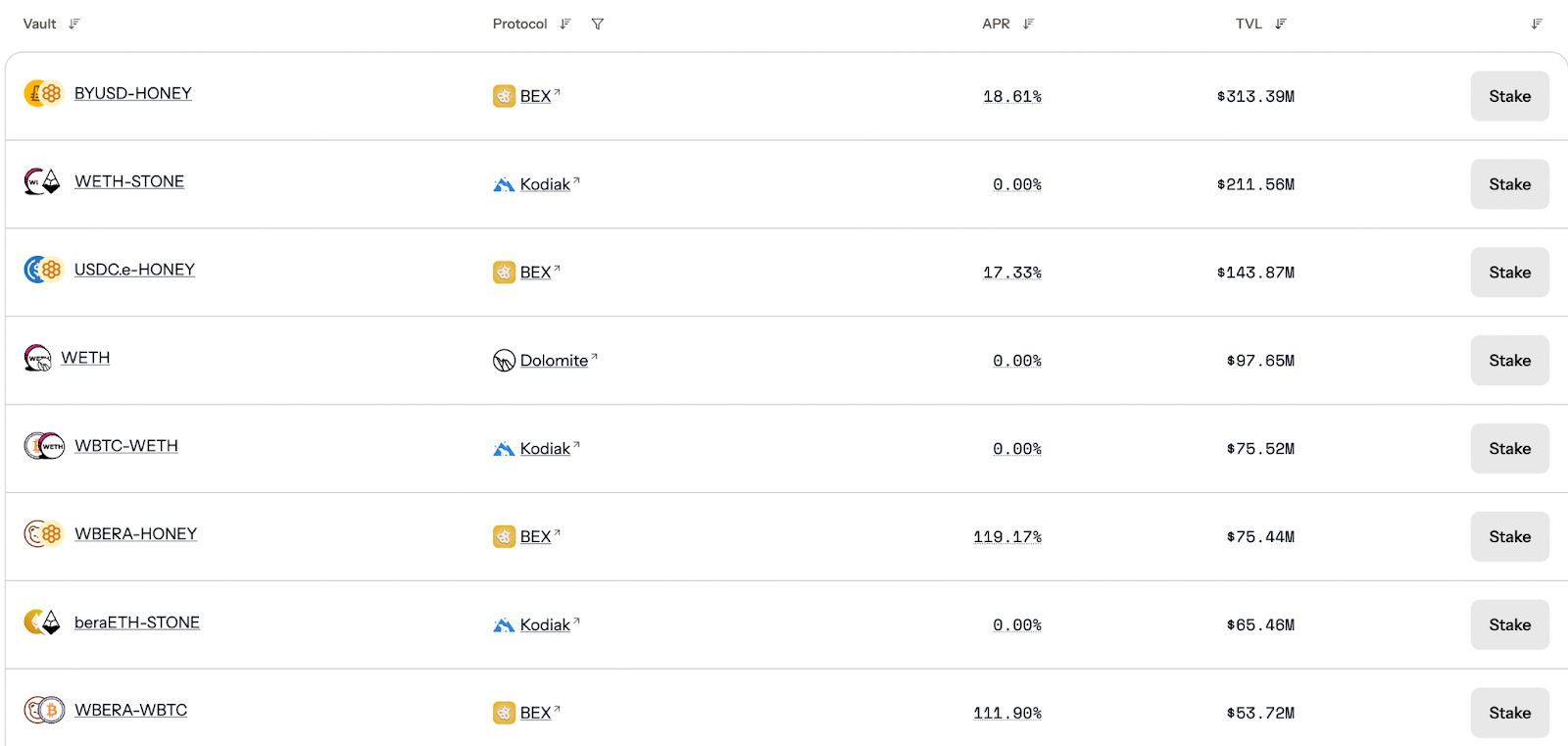
Infrared liquidity pool. Image source: Infrared Official Website
Under Berachain's original model, users must first deposit assets into BEX (Berachain's native DEX) to obtain LP tokens, which are then deposited into the $BGT vault to earn governance token $BGT. However, due to the soul-binding nature of $BGT, which cannot be traded, liquidity is limited, restricting the flexibility of DeFi users.
Infrared Finance provides liquidity by custodizing LP tokens and issuing $i$BGT (liquidity encapsulation of $BGT) at a 1:1 exchange rate, giving it liquidity. Users can directly use $i$BGT to participate in the DeFi ecosystem while still earning $BGT rewards. Users can deposit LP tokens into the Infrared liquidity pool, and the storage operated by Infrared can accept LP tokens from liquidity pools and use these tokens to generate $BGT, while distributing $i$BGT to users corresponding to the amount of tokens they deposited at a 1:1 ratio. Users who obtain $i$BGT can stake i$BGT in Infrared to earn rewards generated by nodes; they can also use i$BGT in other DeFi protocols or sell their i$BGT.
Additionally, Infrared Finance has launched liquidity staking tokens (LST) $iBera, lowering the staking threshold for Berachain. Berachain validators require a stake of 250,000 $BERA (approximately $1.5 million), which is higher than Ethereum's requirement of 32 $ETH (approximately $60,000). However, Infrared's $iBera product allows users to stake $Bera to obtain iBera, enabling ordinary users to participate in staking.
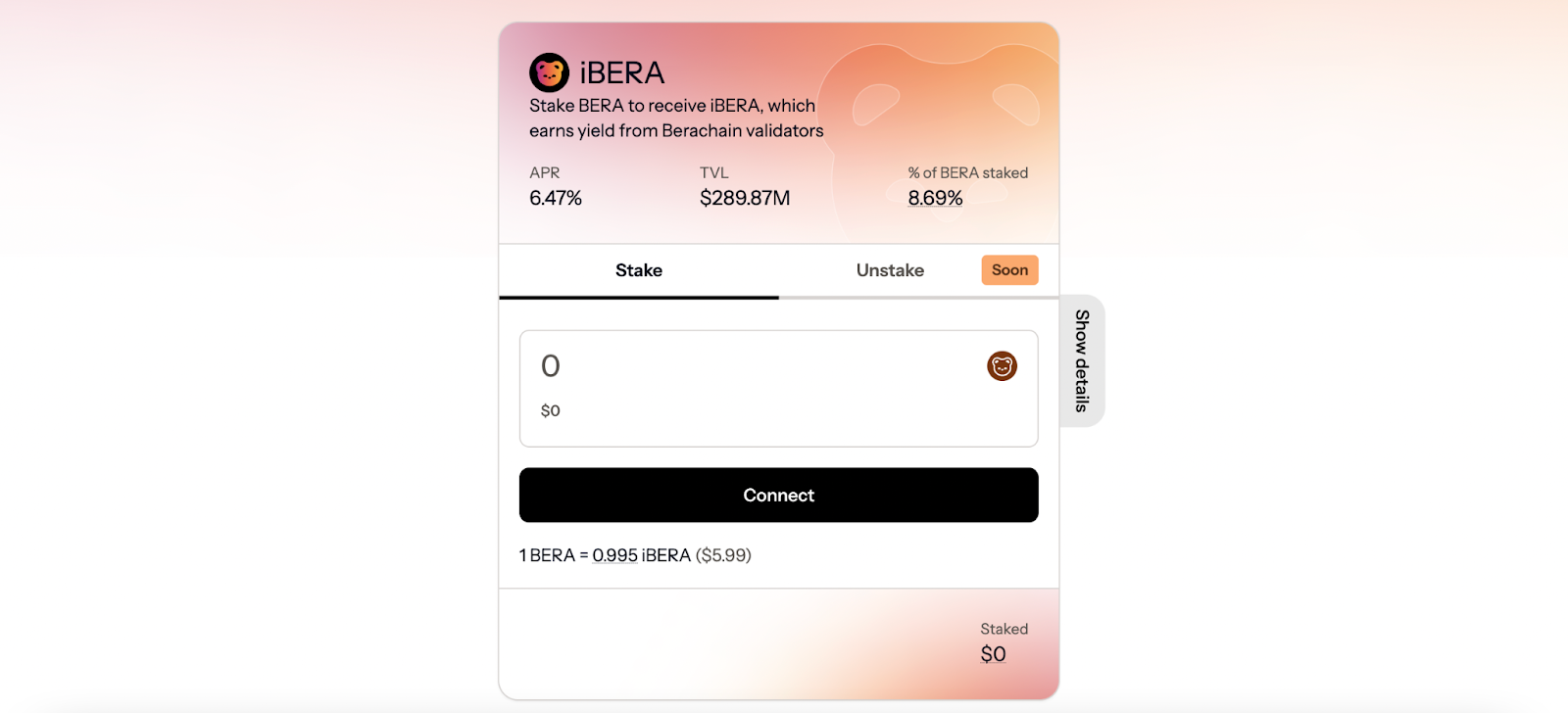
Liquidity staking token $iBera. Image source: Infrared Official Website
With $i$BGT providing liquidity for governance tokens and $iBera lowering the staking threshold, Infrared Finance offers a more convenient way for users to participate in DeFi within the Berachain ecosystem, promising exciting future developments.
As of March 4, 2025, Infrared has completed a total of $18.75 million in financing, including a previous $2.25 million strategic round led by Binance Labs and a $2.5 million seed round, as well as the latest $14 million Series A financing led by Framework Ventures.
BeraPaw is a liquidity staking protocol in the Berachain ecosystem, specifically designed for the Proof of Liquidity (PoL) consensus mechanism, simplifying and automating PoL interactions, enabling users to efficiently unlock the potential of Berachain governance token $BGT. The protocol introduces transferable liquidity staking tokens $L$BGT, allowing users to balance governance rights and liquidity while launching the governance token $PAW, granting holders governance rights over the protocol and enjoying treasury rewards. BeraPaw empowers stakers to earn rewards and governance rights through $L$BGT while allowing $PAW stakers to determine the delegation structure of $BGT, creating a more flexible and efficient staking ecosystem on Berachain.
DeFi - Lending
Dolomite is the next-generation lending protocol on Berachain, supporting a broader range of assets than traditional lending protocols and providing higher capital efficiency. It allows users to lend assets while still being able to stake, unlock, vote, earn rewards, and even participate in the Berachain PoL mechanism, significantly enhancing asset utilization. Additionally, Dolomite offers features for asset recycling, swapping, strategy deployment, and fund management, enabling users to manage funds more efficiently and optimize returns.
Dolomite has launched its native token DOLO on Berachain, with a total supply of 1 billion tokens, of which 20% is allocated to community airdrops, including 9% for active lending users (based on borrowing and deposit data), 10% distributed to Minerals holders in the form of option airdrops (who can purchase DOLO at $0.045), and 1% for core community contributors. On March 5, 2025, Dolomite announced the opening of airdrop queries and plans to conduct a TGE in the coming weeks.
Previously, Dolomite's total financing reached $3.4 million, with investment institutions including NGC Ventures, Draper Goren Holm, Coinbase Ventures, Optic Capital, and several well-known investors. Dolomite is now live on the Berachain mainnet, supporting over 25 assets, and plans to optimize capital utilization using Berachain's Proof of Liquidity (PoL) system.
According to official data, as of March 2025, the total trading volume on the Dolomite platform has reached $870 million, with borrowing exceeding $80.62 million. Users can now deposit $BERA on the platform to enjoy an APR of over 40%, with a deposit supply cap of 5.5 million tokens.
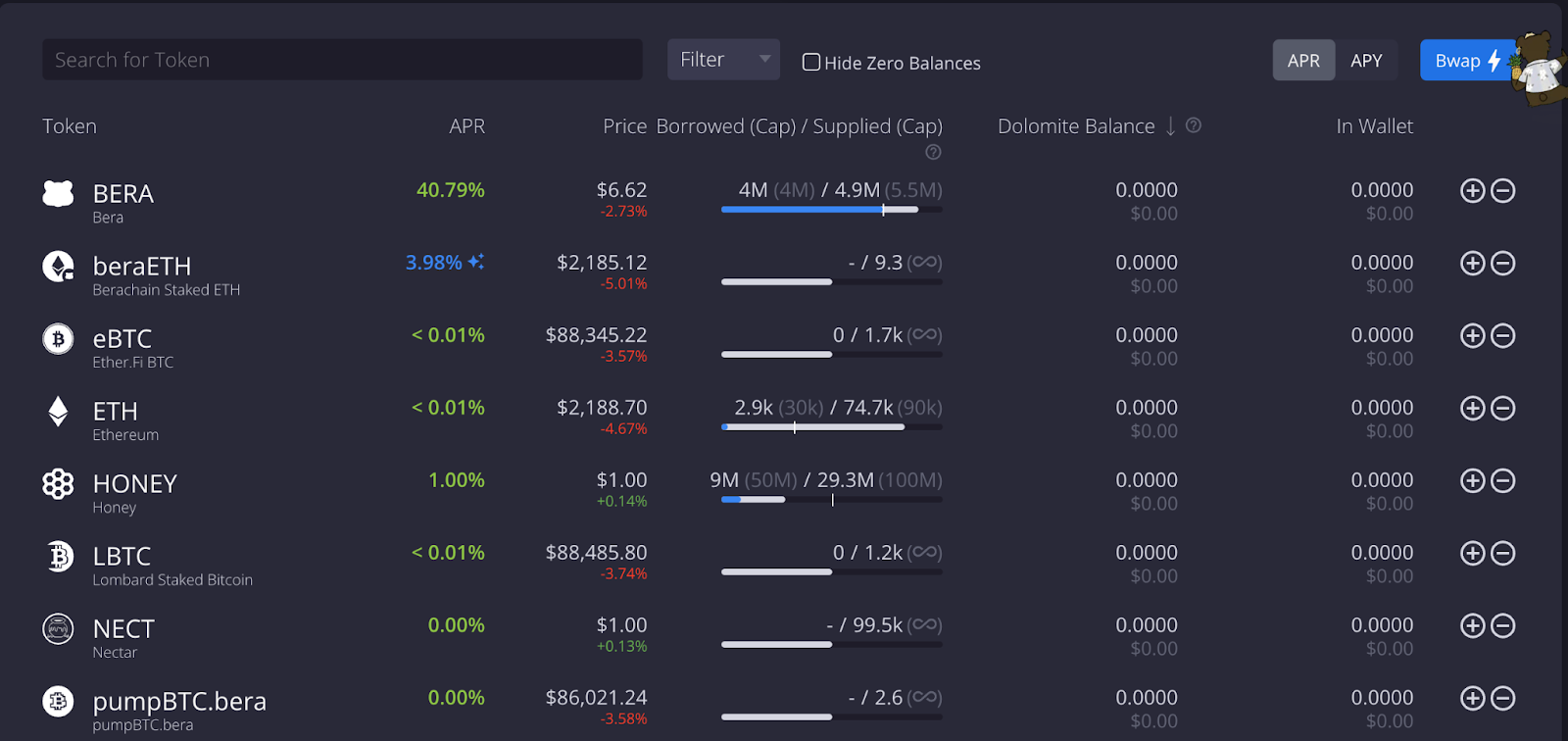
Image source: Dolomite Official Website
Beraborrow is a decentralized lending protocol in the Berachain ecosystem, launching the first PoL-driven stablecoin, Nectar ($NECT), providing instant liquidity for Berachain assets. Users can deposit i$BGT (staking derivatives), LP tokens, and native assets into Dens as collateral to mint $NECT in an over-collateralized manner, using it within the Berachain ecosystem while maintaining exposure to the original assets. The protocol enhances leverage and yield through the PoL mechanism, allowing users to unlock more DeFi opportunities without sacrificing returns. Beraborrow serves as a core infrastructure for Berachain, starting from a CDP platform (Collateralized Debt Position) and gradually expanding to a more comprehensive range of DeFi products, driving ecosystem growth.
Stacking Salmon is a decentralized lending protocol within the Berachain ecosystem, utilizing a set of smart contracts to implement a non-custodial, permissionless lending and leveraged yield farming market. The protocol allows users to leverage positions using Kodiak V3 while optimizing capital availability, providing market makers with higher capital efficiency and enhancing lenders' returns. Stacking Salmon ensures fund security and market stability through dynamic LTV (Loan-to-Value), isolated markets, and the Kodiak V3 TWAP oracle, creating an efficient, secure, and flexible lending environment for the Berachain ecosystem. Its app is currently not officially launched.
Others
Origami is an automated leverage protocol aimed at enhancing capital efficiency in DeFi. By integrating with third-party lending services, Origami automates folding strategies to maximize capital efficiency and reduce liquidation and bad debt risks. Users do not need to monitor health factors or manage positions; they can leverage with just one click. Origami initially launched on Ethereum and has now expanded to Berachain.
Origami Finance has completed $1.5 million in seed round financing. Participants include Ouroboros Capital, Fjord Foundry, Good Partners, Upside, BeraLand, TempleDAO, Boba Tea Capital, Three Three Ventures, Smokey The Bera, and janitooor.eth. Valuation information has not yet been disclosed, and the new funds will be used to build its automated leverage protocol already launched on Ethereum and Berachain.
Veda is the native yield infrastructure for protocols and applications, built specifically for the decentralized finance (DeFi) ecosystem. Users deposit assets into Veda's contracts, which then securely deploy the funds through DeFi protocols. By providing automated and tokenized yield opportunities, Veda simplifies the entire process, allowing users to earn rewards through their assets without facing the complexities of DeFi. Veda's mission is to achieve mass adoption of cryptocurrency through transparent and accessible yields, aiming to fundamentally change how users and protocols interact with yield generation. This innovative approach benefits individual users and enhances the capabilities of various protocols, making yield generation more convenient and efficient.
ApiologyDAO is a decentralized autonomous organization (DAO) that plays a core role in the Berachain ecosystem, operating similarly to a beehive structure, collaborating with the overall Berachain ecosystem. By deploying production hives and supercharged hives within the Berafi Fat Bera Flywheel, ApiologyDAO aims to provide efficient support and growth for the ecosystem, promoting sustainable development and collaborative win-win scenarios. The project is incubated by @0xhoneyjar, driving innovation and cooperation within the Berachain ecosystem.
Ramen Finance is a (3,3) token issuance protocol based on the Berachain ecosystem, designed to provide liquidity guidance for new assets on Berachain. The protocol is community-owned and governed.
Concrete is the native foundational protocol for generating credit products and derivatives, opening the door to building a new set of financial primitives for on-chain assets using Concrete as a computational base layer. It provides secure, automated yield strategies and derivatives for user assets, helping users earn the highest returns and reduce trading risks. After its launch, Concrete will serve users of money markets such as Aave, Compound, Silo, and Radiant, regularly adding both mature and emerging lending institutions.
GameFi
BeraTone is a multiplayer online life simulation game based on the Berachain ecosystem, available for PC and mobile devices. The core experience of the game revolves around farming and life simulation, where players can own their land in a virtual world, customize and expand it freely, and engage in activities such as planting, resource gathering, raising animals and livestock, and trading with other farmers. The rich game economy of BeraTone is enhanced by Berachain's innovative Proof of Liquidity (PoL) consensus mechanism, allowing players to access Berachain's native decentralized applications (dApps) and cooperative agreements within the game, all systems are optional and do not interfere with the gaming experience, aiming to provide a seamless experience for Web2 players.
Wizzwoods is a cross-chain synthesis simulation game that combines Web2 social traffic with Web3 gaming experiences. Players can enhance farm management efficiency and enrich their adventure journeys by collecting and combining NFTs from different EVM chains. The core gameplay of the game involves building farms, where players continuously optimize management to improve efficiency and experience the fun of cross-chain synthesis. In about six months, Wizzwoods has accumulated over 3 million players on TG, with over 2 million monthly active users and over 500,000 daily active users, generating over $4 million in in-game purchase revenue.
Beramonium is a large game project developed on Berachain, with its first game "Gemhunters" being an idle role-playing game. Players can send their Beramonium Genesis Beras on missions to acquire equipment and gems. These gems can be exchanged for NFTs related to other Berachain projects, such as Honey Combs, Beradoges, and more.
Beramonium Chronicles: Genesis is a collection of 6,000 unique NFTs, initially minted at a price of 0.045 ETH. These NFTs serve as a gateway to the Berachain NFT and gaming ecosystem, aiming to attract real players into the crypto world, explore the charm of NFTs, and enjoy gaming fun. Players can participate in the "Gemhunters" game by visiting Beramonium's official website, sending their Beras on missions, collecting gems, and exchanging them for NFTs from other Berachain projects.
Meme
Memeswap is a gamified social DEX built on Berachain, allowing users to issue tokens, earn yields, and build their own communities. The platform focuses on launching meme coins, offering innovative features such as low-cost token issuance, AI functionality integration, anti-bot and whale mechanisms, and time-locked liquidity pools. Users can deploy LP pools by leasing liquidity from staking vaults without raising funds and utilize AI to automatically generate or adjust token images. The platform has an anti-whale mechanism that limits each address to one transaction every 30 seconds and sets a cap on each transaction to prevent multiple trades and hoarding. Liquidity pools will be locked for at least one day to ensure the security of initial trades. Additionally, developers must meet liquidity standards within a specified time; otherwise, the liquidity pool will automatically dissolve, and liquidity will be returned to the vault. Through the PoL mechanism, compliant liquidity pools will be permanently locked and staked in DeFi protocols to earn PoL rewards.
Henlo is a meme coin project built by the largest community on Berachain, The Honey Jar (abbreviated as THJ). $HENLO, as a meme coin on the mainnet, is inspired by the English word "hello," but expressed in a more distinctive way, becoming a mainstream term within the Berachain community. THJ has established partnerships with multiple ecosystem projects, thus holding significant influence within the community. Henlo is not just a greeting; it also represents a lifestyle and community culture, becoming one of the symbols on Berachain.
$PLUG is the first ERC20 token of the Berachain community, powered by Beraplug. Beraplug is a (3,3) reinforcement protocol designed to reward long-term community alignment and probabilistically transfer asset supply from weak hands to strong hands. The $PLUG token is the first implementation of the Beraplug protocol, primarily aimed at The Honey Jar's Honey Comb NFT. This token design aims to enhance the long-term stability of the community and promote quality asset distribution among holders.
SocialFi
Honey Chat is a decentralized social network and finance (SocialFi) application designed to combine social interaction with crypto innovation, reshaping the landscape of digital interaction. The platform puts control, ownership, and monetization directly in the hands of content creators and audiences, allowing fans, creators, and influencers to connect seamlessly. In Honey Chat, your social interactions are not just likes and shares; they are imbued with the value of digital currency. This is a place where consumer cryptocurrency and creator economy seamlessly merge, creating a massive wave in the SocialFi space. Click here to participate in HoneyChat.
RWA
BurrBear is a stablecoin liquidity hub within the Berachain ecosystem, focusing on providing innovative DeFi liquidity pools for stablecoin issuers, RWA (real-world assets) tokens, stablecoins, and hardware asset tokens. These liquidity pools not only enhance liquidity but also improve yields, providing more efficient capital utilization solutions for on-chain and off-chain assets.
HiveBits is an RWA (real-world assets) project that utilizes DePIN (Decentralized Physical Infrastructure Network) to bring beekeeping on-chain, promoting sustainable beekeeping and hive health. The project combines blockchain technology with traditional agriculture, allowing global users to participate in eco-friendly beekeeping through tokenized hives, collectively supporting sustainable development.
Fortunafi is a cross-chain RWA (real-world assets) tokenization issuance platform focused on providing integrated liquidity solutions for stablecoin issuers, protocol treasuries, and traditional financial institutions. Its investment products cover private and public debt and support native minting and redemption on top-tier blockchains, facilitating the on-chain liquidity of traditional financial assets.
NFT
Kingdomly is Berachain's native NFT launch platform and marketplace, designed to provide no-code NFT creation, minting, and trading services for creators and collectors. With Kingdomly Creator, anyone can create high-quality NFT collections without technical knowledge. The platform also offers an NFT Bridge feature, supporting cross-chain NFT transfers, enhancing the liquidity and accessibility of digital assets. Additionally, Kingdomly Mint is a centralized platform specifically for minting collections on the Berachain mainnet, providing a seamless and cost-effective minting experience. Currently, Kingdomly is developing staking features, which are expected to further enhance the platform's user experience and ecosystem participation.
Click here to learn more about Berachain ecosystem projects. Meanwhile, FenTech has compiled a list of native projects on Berachain based on data from @Berasearch, covering brief introductions to over 80 projects. Click here for details.
3.2 Boyco Pre-deposit Activity
Boyco is a pre-deposit activity that provides users with an early opportunity to participate in the Berachain ecosystem, launched in collaboration with Brachain and @roycoprotocol. Participants can earn rewards in $BERA tokens and project tokens through deposits. The goal of Boyco is to raise sufficient liquidity before the launch of the Berachain mainnet, ensuring support for various applications and transactions after the mainnet goes live. Participants can engage in this liquidity market by depositing funds in advance (including pre-pre-deposits). There are four partners: StakeStone, Lombard, Ethena Labs, and etherfi.
3.6.1 BeraChain & Stakestone
Participation link: https://app.stakestone.io/u/vault/detail/bera
Users will be able to participate in the Berachain ecosystem and earn yields using liquidity assets STONE, ssBTC, and STONEBTC from StakeStone. StakeStone is a full-chain liquidity asset protocol focused on building liquidity distribution for ETH, BTC, and stablecoins, launching a full-chain yield-generating ETH asset—STONE—to continuously optimize the yield structure for users.
StakeStone has reached a strategic partnership with Berachain to launch the Berachain Pre-deposit Vault. This product achieves three core functions through a smart strategy engine:
Automated yield aggregation system: Builds dynamic yield models based on real-time on-chain data, supporting intelligent cross-chain fund optimization.
Liquidity optimization architecture: Employs a layered risk control mechanism to ensure asset security while enabling seamless flow of funds across multiple ecosystems.
One-click yield enhancement: Helps users automatically capture the best investment window for $BERA through algorithm-driven asset rebalancing strategies.
Unlike traditional yield aggregators, this solution innovatively introduces modular yield strategy combinations, achieving compound growth of yields in the cross-chain DeFi ecosystem while ensuring verifiable transparency of underlying assets. The system continuously monitors over 20 yield parameters, dynamically adjusting fund allocation plans to ensure that user assets are always on the optimal yield curve.
The StakeStone Berachain Vault achieves deep utilization of LPs and yield amplification, allowing users participating in the StakeStone Berachain Vault to earn multiple layers of yield.
Users deposit assets (such as ETH) into StakeStone, obtaining full-chain liquidity assets like STONE, capturing PoS underlying yield.
Users deposit LP assets (such as STONE) into the Berachain ecosystem, and the Vault automatically maximizes liquidity mining and governance yields for users. At the same time, users will receive yield-bearing asset Vault LP Tokens (such as beraSTONE).
Users can use these yield-bearing assets in other DeFi projects, such as Uniswap liquidity mining, Aave/Morpho collateral lending, etc., generating multiple yields.
According to official data, Berachain and StakeStone have gained widespread attention since their launch, with the pre-deposit Vault currently generating $327 million in TVL.
3.6.2 BeraChain & Ethena
Participation link: https://ethena.concrete.xyz/
Ethena is a stablecoin protocol aimed at converting Ethereum assets into yield-generating stablecoin USDe through derivative infrastructure. USDe is supported by crypto assets and delta-neutral hedging strategies. Ethena provides yields for users by capturing interest rate differentials between CeFi, DeFi, and TradFi, promoting capital and interest rate convergence across different financial systems.
The collaboration between Ethena and Berachain centers around incentive pre-deposit vaults, forming an innovative model for cross-ecosystem yield aggregation. According to official announcements, the first products of the collaboration are launched on the Concrete platform, including two pre-deposit vaults that support users depositing USDe, sUSDe, and assets like USDC/USDT. The core value of this design lies in allowing users to participate in ecosystem incentives without directly interacting with Berachain's native assets while retaining exposure to dollar stablecoins, achieving risk-controlled cross-chain yield capture.
The technical architecture of the collaboration consists of three layers:
Asset Layer: Ethena provides underlying asset support through its USDe stablecoin's delta-neutral mechanism (based on ETH staking yields and futures hedging). The USDe/sUSDe deposited by users will automatically trigger Ethena's yield strategy (staking yield + arbitrage yield), forming the source of basic returns;
Protocol Layer: Berachain's Proof of Liquidity mechanism is integrated into the vault, converting user deposits into liquidity certificates required for validator nodes. This is achieved through its dual-token system ($BERA as the gas token and $BGT as the governance token), binding liquidity contributions with network security;
Incentive Layer: Users can simultaneously receive four types of rewards—native yields from the Ethena protocol, Concrete points (for future governance rights distribution), airdrops of the Berachain mainnet token $BERA, and additional incentives from whitelisted protocols within the ecosystem (such as DEXs and lending platforms).
User participation paths can be divided into three phases:
Pre-deposit Period: Before the launch of the Berachain mainnet, users deposit assets through the Concrete platform, with funds temporarily held in an Ethereum chain custody contract. The system allocates Concrete points and Ethena rewards based on the deposit ratio;
Deployment Period: After the mainnet launch, funds will automatically cross-chain to Berachain, allocated to whitelisted protocols according to preset strategies, starting to accumulate $BERA tokens and ecosystem rewards;
Yield Compounding Period: Users can choose to re-stake the obtained $BERA to validator nodes, enhancing the acquisition efficiency of the $BGT governance token through the Proof of Liquidity mechanism, thereby participating in ecosystem governance or redeeming for $BERA to realize yield cycles.
This collaborative model innovatively couples Ethena's on-chain stablecoin yield engine with Berachain's Proof of Liquidity consensus, forming a dual-spiral model of "stablecoin yield + public chain ecosystem growth." The Ethena pre-deposit vault TVL has reached $135 million.
3.6.3 Berachain & Etherfi
Participation link: https://app.ether.fi/liquid/bera-eth
Etherfi is a non-custodial staking protocol based on the Ethereum network, allowing users to control their keys while staking Ethereum (ETH), thereby reducing counterparty risk from node operators and protocols. Its core mechanism is to provide economic security for Ethereum scaling solutions, oracles, and other external systems through re-staking via EigenLayer, thus enhancing staking yields.
The incentive pre-deposit vault launched in collaboration with ether.fi supports users depositing various assets, including: weETH (Wrapped eETH), WETH (Wrapped ETH), stETH (Lido staked ETH), eBTC (Bitcoin-backed asset from ether.fi), wBTC, cbBTC (Coinbase custodial BTC), and LBTC (liquid BTC derivatives). Users can deposit the supported assets into the Berachain incentive pre-deposit Vault on ether.fi to participate in this collaboration. After the launch of the Berachain mainnet, deposits will be locked for 90 days and cannot be withdrawn during this period. Users will receive rewards from the Berachain protocol, as well as additional incentives provided by ether.fi.
Through this collaboration, users can not only participate in the Berachain ecosystem but also earn multiple yields during the lock-up period, further promoting Ethereum staking and decentralized finance development.
3.6.4 BeraChain & Lombard
Participation link: https://www.lombard.finance/berachain/
Lombard is an emerging project in the Bitcoin re-staking ecosystem, based on the Babylon protocol, providing cross-chain liquid staking for Bitcoin, allowing Bitcoin holders to participate in PoS ecosystems and earn yields without trust. Its core product, LBTC, is a yield-bearing, cross-chain, highly liquid Bitcoin asset, backed 1:1 by BTC. Users can stake BTC through the Babylon staking protocol to mint LBTC and use it in DeFi protocols on Ethereum and Layer 2 ecosystems (such as lending, trading, and staking). LBTC addresses the lack of native yield and cross-chain composability for Bitcoin in the DeFi space, unlocking Bitcoin's liquidity and promoting the development of the entire DeFi ecosystem.
As a BTC liquidity protocol, Lombard collaborates with Berachain to launch the Boyco market pre-deposit vault, supporting users to deposit LBTC (liquid BTC derivatives) and wBTC (Wrapped BTC).
Users can deposit LBTC or wBTC into the designated Berachain vault and will receive receipt tokens representing their deposit rights, which will be used for subsequent reward distribution and redemption. Users' points will accumulate from the deposit until April 14, 2025 (limited to 14 weeks), after which they can withdraw principal and earnings. After the mainnet launch, funds will be automatically deployed into Berachain's DeFi protocols, continuously generating actual yields.
Participants can simultaneously receive the following rewards:
$BERA token airdrop: As the native token of Berachain, the $BERA rewards will be distributed from a total allocation of 2% (i.e., 10 million tokens), expected to be distributed in early May 2025.
Multi-project point stacking: Including 4x Lombard points (possibly related to Lombard Lux points), 1x Babylon points, 4x Concrete points, 1x Kodiak points, and 1x Dolomite points, which can be exchanged for tokens or rights in the cooperative ecosystem in the future.
Potential DeFi yields: After the mainnet launch, funds will be automatically invested in liquidity mining and other strategies to further generate yields.
Users can earn multi-project points and $BERA token rewards through simple deposits, while injecting liquidity into the mainnet DeFi ecosystem.
The Boyco pre-deposit activity provides DeFi users with a low-threshold opportunity to earn multiple yields; it also helps the Berachain protocol quickly attract funds and attention before the mainnet launch, stimulating community activity. According to Dune Analytics @Zero_Labs data analysis, during the Boyco activity, a total of 154,000 addresses participated, with a staking amount of $1.57 billion, of which the staking amount on Etherfi was the highest, accounting for 41.7%, while the staking amount on Ethena was the lowest, accounting for 8.7%. The top three most popular staking assets were WETH, LBTC, and eBTC.

Boyco activity data. Source: Dune Analytics
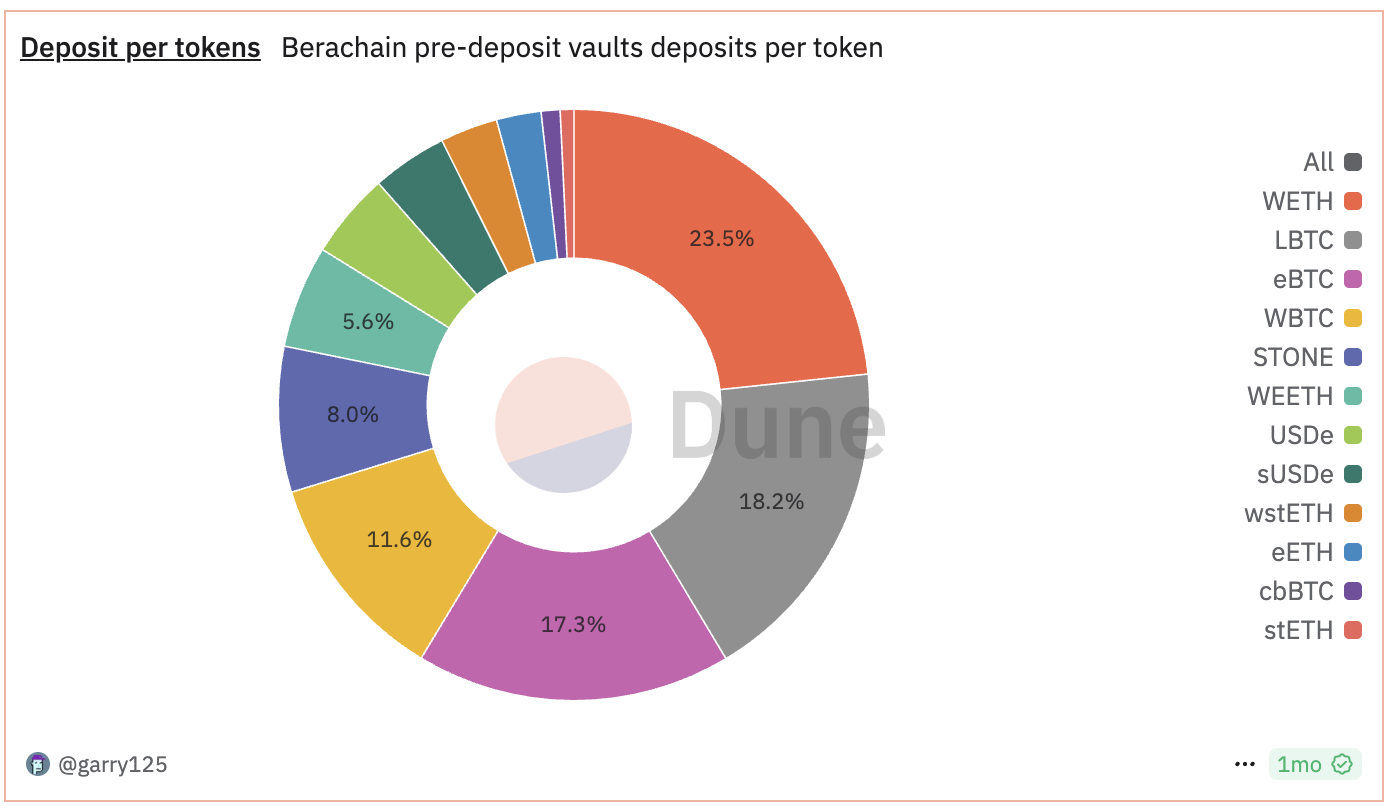
Boyco activity data. Source: Dune Analytics
- Current Status
4.1 Mainnet
The Berachain mainnet launched on February 6, 2025, and as of March 18, its TVL was $2.902 billion. According to Defillama data, Berachain's TVL has now surpassed Base and Sui chains, ranking 6th among all public chains, following Ethereum, Solana, Bitcoin, BSC, and Tron. From the line chart below, it can be seen that since the mainnet launch, Berachain's TVL has been steadily increasing, with a slight decline after March, peaking at $3.23 billion.
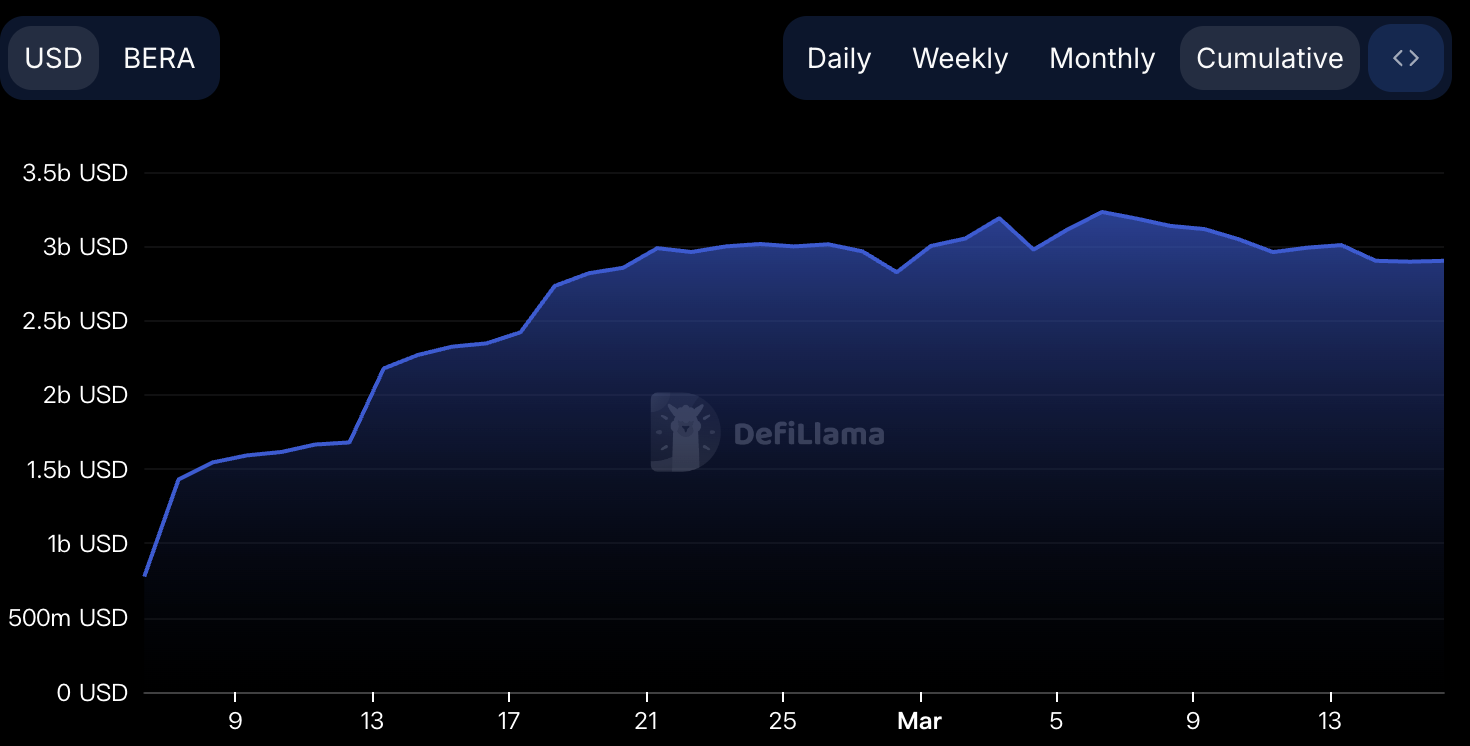
Public chain TVL line chart, data source: Defillama
According to the data shown in the chart below, as of March 18, the cumulative transaction volume on the Berachain mainnet reached 65.52 million, with the current block height at 2,486,640, TPS at 12.3, and the highest TPS since launch at 28. The current average block time is 2 seconds. A total of 57,256 smart contracts are currently deployed on Berachain.

Berachain mainnet data. Data source: Berascan. Date: 2025.03.18

Berachain TPS data. Source: Dune Analytics
4.2 Nodes
According to the official documentation from Berachain, there are two types of nodes in Berachain: validator nodes and RPC nodes. Each node can be configured as a full node or an archive node, and each type of node is a combination of an execution client and a consensus client. Berachain is a Layer 1 chain that is EVM-equivalent, meaning it supports any EVM execution client at the execution layer. These clients work in conjunction with the consensus client and framework built by Berachain, collectively forming BeaconKit.
To become a node in Berachain, one must first stake 250,000 $BERA. Running a node requires meeting the following hardware requirements:
Operating System: Linux AMD64, Linux ARM64, MacOS ARM64
CPU: 8 cores
Memory: 48GB
Storage: 4TB (high IOPS SSD)
Block rewards are in the form of $BGT, with the base reward for each block on the mainnet being 0.5 $BGT. Rewards are not automatically distributed and must be allocated through the Distributor contract. The maximum number of nodes allowed to run on Berachain is 69, with 60 currently deployed, generating a total of 3.88 million $BGT and staking 184 million $BERA. According to Dune Analytics, the highest daily $BGT yield since the mainnet launch was 245,175 tokens.

Data source: Berachain Official Website

Berachain $BGT reward generation situation. Data source: Dune Analytics
The Berachain official website lists information on the current 60 validators, with the highest $BGT production coming from Infrared by Luganodes, which has produced 558,500 $BGT, operated by Infrared Finance.
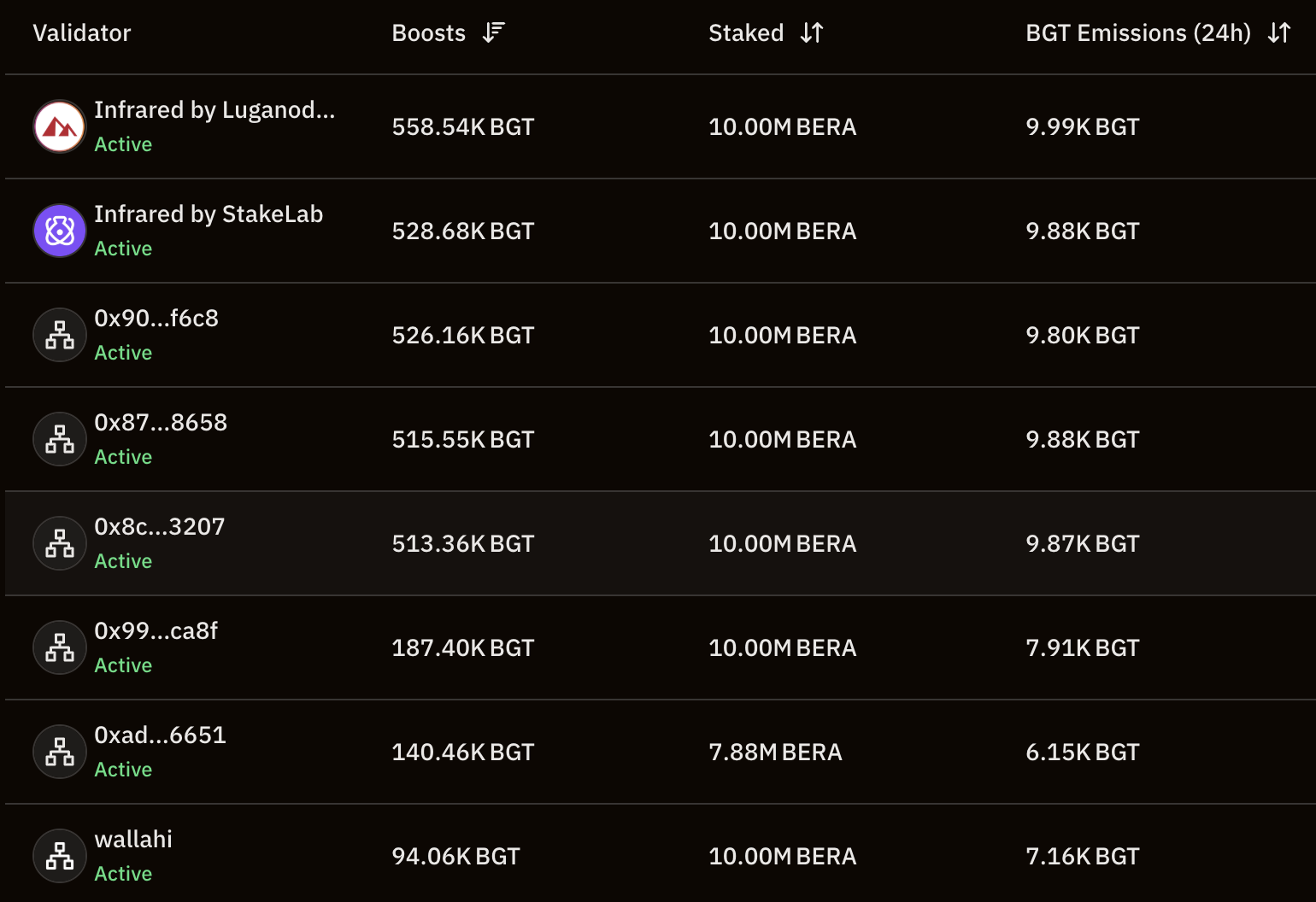
Berachain node rankings. Data source: Berachain Official Website
4.3 Token $BERA
Currently, its native gas token $BERA has been listed on several exchanges, including Binance, OKX, Coinbase, and Bybit.
$BERA Token Distribution
Total Supply: 500,000,000 $BERA
- Core Contributors - 84,000,000 tokens (16.8%)
- For advisors and core contributors supporting the construction of the Berachain ecosystem.
Investors - 171,500,000 tokens (34.3%)
- For seed round, Series A, and Series B investors.
Community Distribution - 244,500,000 tokens (48.9%) The development of Berachain relies on a strong community and developer ecosystem. Community distribution includes the following three major parts:
Airdrop - 79,000,000 tokens (15.8%): Applicable to testnet users, Berachain NFT holders, ecosystem NFT holders, social supporters, ecosystem project dApps, community builders, etc.
Future Community Incentives - 65,500,000 tokens (13.1%): Support applications, developers, and users through incentive programs, grants, etc., with specific plans determined by community voting (Snapshot, RFP).
Ecosystem & R&D - 100,000,000 tokens (20%): Used to support ecosystem development, R&D, growth plans, and the operation of the Berachain Foundation, focusing on:
Developer and builder incentives (Boyco program)
Node operator (validator) incentives
Proof-of-Liquidity and BeaconKit iterations
Additional Notes:
- 9.5% of the $BERA tokens will be unlocked at launch for ecosystem growth, development tools/infrastructure, liquidity provision, etc.
Lock-up rules: All allocation entities (team, investors, community) must have a 1-year lock-up period, after which they will be unlocked in phases: 1/6 will be unlocked after the first year; the remaining 5/6 will be released linearly over 24 months.
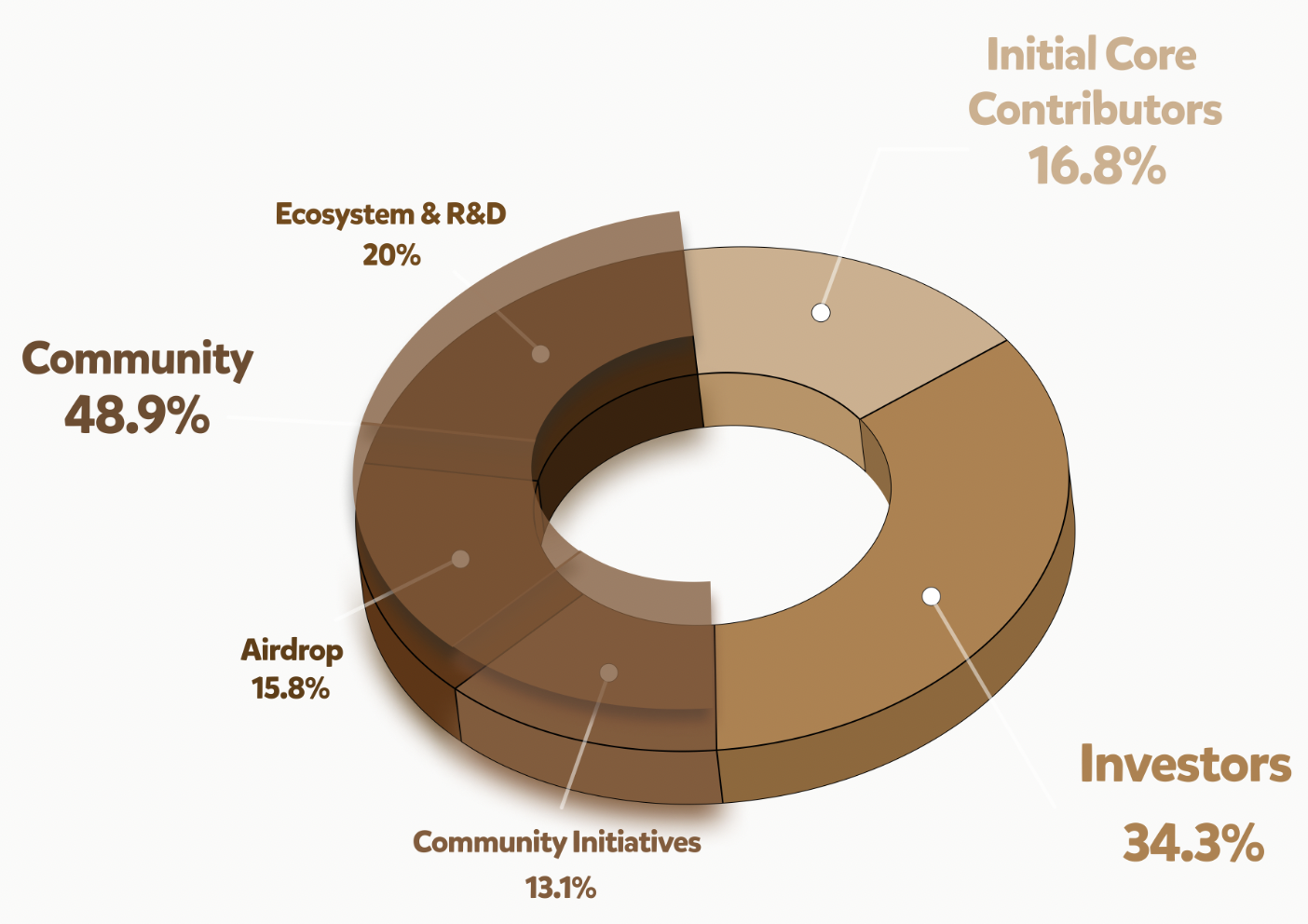
Image source: Berachain Tokenomics
According to CMC data, since $BERA was listed on multiple exchanges in February, the token price has fluctuated around $6 to $8, with the current price being $6.4 and a market cap of approximately $698.59 million.
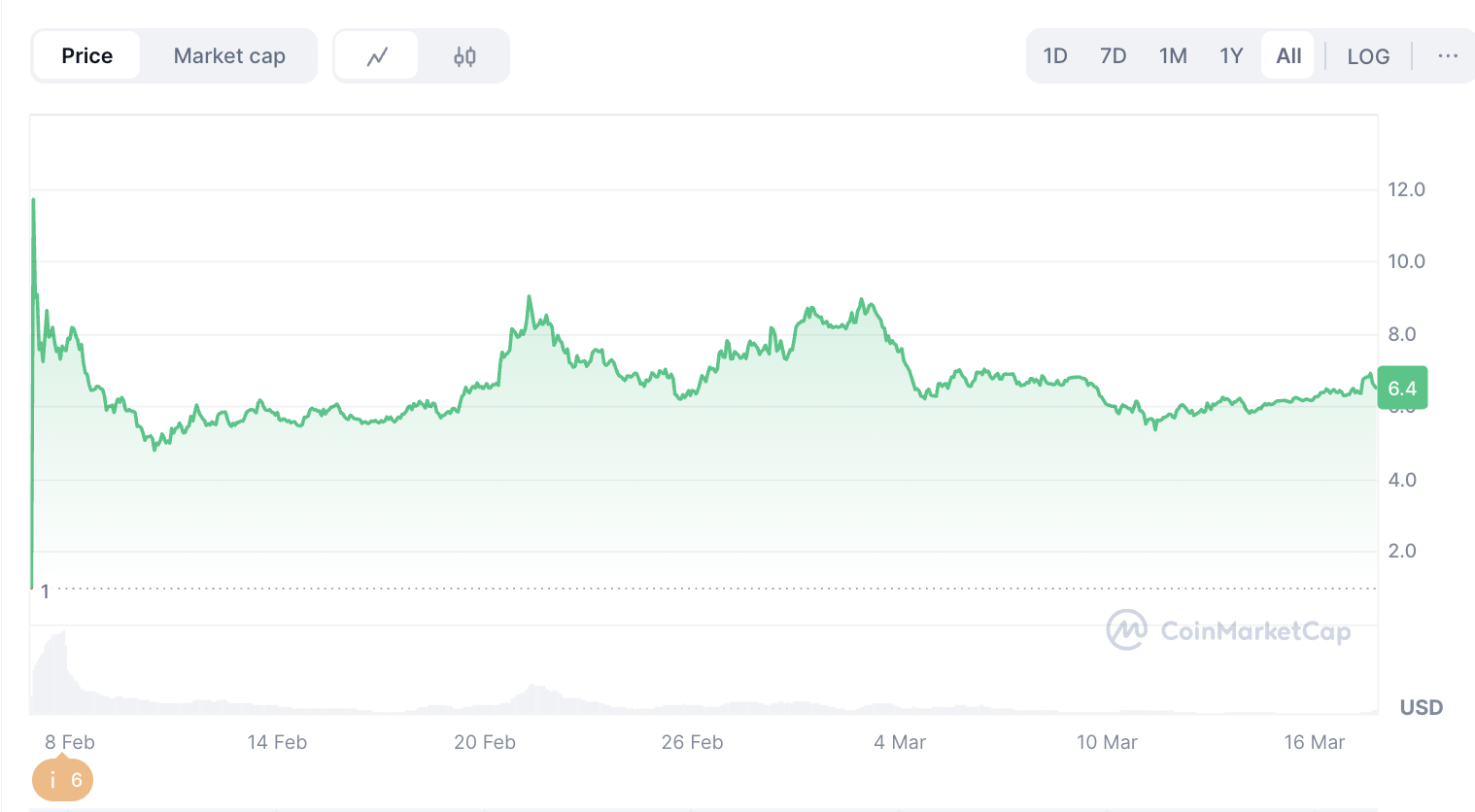
$BERA price trend chart. Data source: CoinMarketCap
- Team and Funding Background
The core team of Berachain consists of seasoned industry professionals covering areas such as technology, developer relations, DeFi, research, and business development. Co-founders include Smokey and Dev Bear (previously served as CTO). Team members include Camila Ramos (head of developer relations, formerly an engineer at Fuel Labs and PayPal), Jack Melnick (DeFi lead, formerly DeFi lead at Polygon), knower (crypto researcher), and Leslie Song (APAC BD, formerly head of business growth for AAVE in Asia).
Recently, the Berachain Foundation officially appointed Paul O’Leary as the new Chief Technology Officer (CTO). O’Leary previously served as CTO of Polygon Labs and has 20 years of entrepreneurial and executive experience in blockchain and big data. Since joining Berachain earlier this year, he has led the team in advancing the mainnet launch and will continue to drive Berachain's development.
Since its inception, Berachain has attracted significant attention. As a Layer 1 blockchain built on the Cosmos SDK and compatible with EVM, Berachain employs an innovative PoL consensus mechanism and empowers the network with strong functionality and flexibility through a three-token system ($BERA, $HONEY, $BGT).
Key funding events:
April 2023, Berachain completed $42 million in Series A funding, led by Polychain Capital, with participation from OKX Ventures, Hack VC, Dao5, Tribe Capital, Shima Capital, Robot Ventures, Goldentree Asset Management, and 20 DeFi project founders including Celestia founder Mustafa Al-Bassam and Tendermint co-founder Zaki Manian.
March 2024, Berachain secured $69 million in funding, with a post-money valuation of $1.5 billion.
April 2024, Berachain announced that the Series B funding scale increased to $100 million, approximately 45% higher than previously reported. This round was led by Brevan Howard Digital (Abu Dhabi subsidiary) and Framework Ventures, with participation from Polychain Capital, Hack VC, Tribe Capital, etc. The funds will be used for international expansion and further development.
- Challenges
As an emerging Layer 1 public chain, Berachain has attracted market attention with its Proof of Liquidity (PoL) mechanism and innovative economic model, but it still faces multiple challenges that need to be assessed from various dimensions, including regulation, technical security, and ecosystem development:
Regulatory Risks: Policy Uncertainty and Compliance Pressure
Berachain's stablecoin $HONEY is pegged to USDC and claims to be "over-collateralized by at least 150%." However, if the collateral mechanism or actual reserve transparency is insufficient, it may face regulatory scrutiny similar to Tether. Additionally, if $HONEY becomes unpegged due to market fluctuations, it could trigger systemic risks and lead to regulatory intervention.
Cross-chain assets integrated through the Boyco program (such as wBTC, LBTC, etc.) may face risks of asset freezing or cross-chain bridge shutdowns if they involve non-compliant issuers or custodians.
Technical Security Risks: Longevity of the PoL Mechanism and Governance Vulnerabilities
- As a new consensus mechanism, the PoL and its three-token model still need to be tested for security and stability by the market and time. Its core design, including the non-transferability of the $BGT token and the reward distribution relying on a bribery mechanism, has not yet undergone large-scale network stress testing. If the incentive mechanism becomes unbalanced or liquidity is too dispersed, it could lead to validator centralization or a decline in network security. Furthermore, potential vulnerabilities during technical deployment, the long-term effectiveness of liquidity incentive design, and issues related to cross-chain interoperability all require continuous optimization and improvement during actual operation.
Ecosystem Development Risks: Sustainability of Growth and Competitive Pressure
- Currently, Berachain's TVL (over $3 billion) mainly relies on pre-deposits from the Boyco program and short-term speculative funds, which still lags behind established ecosystems like Ethereum, Solana, and BNB Chain. If the actual applications post-mainnet launch fail to attract real users and trading demand, it may fall into a "high TVL, low activity" dilemma, leading to capital withdrawal and token sell-offs. Competing with large, mature public chain ecosystems to attract more DeFi protocols and users remains a long-term challenge for Berachain.
Token Economic Model Risks: Possibility of a Spiral Downturn
- The design allowing $BGT to be exchanged 1:1 for $BERA may delay selling pressure, but if ecosystem returns fall short of expectations, users may concentrate on exchanging and selling $BERA, creating a negative feedback loop of "decreased $BGT demand → $BERA price drop → weakened ecosystem attractiveness."
- Summary
Berachain builds differentiated competitiveness through the PoL consensus mechanism, the Boyco pre-deposit program, and a multi-layered ecosystem layout, attracting over $3 billion in deposits and laying a solid foundation for the mainnet launch.
Its PoL mechanism allows users to participate in validation with various assets, converting liquidity into security and ecological value; the Boyco program enhances ecosystem stability by providing multiple rewards through the early locking of ETH and BTC assets; additionally, Berachain deeply integrates DeFi, GameFi, and SocialFi, enhancing capital efficiency through the governance token $BGT.
With technological innovation, ecosystem incentives, and community-driven efforts, Berachain is occupying a unique ecological position in Layer 1 competition. If it continues to optimize performance and improve capital retention rates, it is expected to become an important cornerstone of the DeFi ecosystem.
Although Berachain's innovation gives it a unique narrative in Layer 1 competition, its risks cannot be ignored: regulatory scrutiny of stablecoins, verification of the longevity of the PoL mechanism, and the transition of the ecosystem from "capital-driven" to "demand-driven" are all key challenges. Investors should be wary of the risk of value return after the short-term speculative frenzy subsides and closely monitor subsequent actual data performance.
Berachain Community
Website | Whitepaper | Twitter | Telegram | Discord
References
Battle for $BGT: Exploring user, validator and protocol demand for $BGT
What's possible on Berachain: A look at key dApps and strategies on mainnet
What is Berachain, the new public chain that raised $42 million from the start?
DeSpread: Discussion on the ecological characteristics of Berachain and an overview of core projects
Berachain Good Article Translation | Exploring the differences between PoS and PoL
Exploring the Bear Chain ecosystem: 34 projects you need to know
Must-read before the mainnet launch! A comprehensive guide to understanding Berachain
Berachain Bear Chain Ecosystem "Infrared" Step-by-step Interaction Process
Berachain Bear Chain Ecosystem "Kodiak" Step-by-step Interaction Process
Berachain Airdrop is here, keep this token guide and navigation for 80+ ecological projects handy
Berachain mainnet is about to launch, how can StakeStone Vault bring maximum returns?
Comprehensive Interpretation of Ethena: A New Generation of Cryptocurrency Federal Reserve
Unlocking $1.3 trillion in funds? How Lombard enhances passive income for BTC?
Upgrading Curve gameplay to L1: Opportunities and risks for Berachain
Berachain ($BGT): A modular EVM-compatible blockchain innovator driven by Proof of Liquidity
Exploring Berachain: Analysis of Native Protocol and Technical Highlights
Original link: Berachain: A panoramic analysis of underlying innovations and ecological evolution in Web3
免责声明:本文章仅代表作者个人观点,不代表本平台的立场和观点。本文章仅供信息分享,不构成对任何人的任何投资建议。用户与作者之间的任何争议,与本平台无关。如网页中刊载的文章或图片涉及侵权,请提供相关的权利证明和身份证明发送邮件到support@aicoin.com,本平台相关工作人员将会进行核查。



